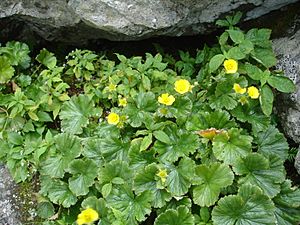Spreading avens facts for kids
Quick facts for kids Spreading avens |
|
|---|---|
 |
|
| Conservation status | |
| Scientific classification | |
| Genus: |
Geum
|
| Species: |
radiatum
|
| Synonyms | |
|
|
Geum radiatum, also called the spreading avens or Appalachian avens, is a special flowering plant. It belongs to the rose family. This plant is very rare. It grows naturally in the mountains near the border of Tennessee and North Carolina in the southeastern United States. Only about eleven groups of these plants are still known to exist. Because it is so rare, the U.S. government officially listed it as an endangered species in 1990.
Contents
About the Spreading Avens
The spreading avens is a type of plant that lives for many years. It has a special underground stem called a rhizome. This rhizome spreads out under the soil. From this rhizome, many groups of leaves grow. These leaf groups are called rosettes.
What Does It Look Like?
What might look like many separate plants are often all connected. They are actually copies of one single plant. This is because the plant can make new plants from its roots. This is called vegetative reproduction. The large leaves of the spreading avens are shaped like a kidney. Its stems can grow from 20 centimeters (8 inches) to half a meter (20 inches) tall. Bright yellow flowers bloom on these stems during the summer. This Geum plant looks very different from other similar plants in the area. Its closest plant relative is likely Geum peckii. However, Geum peckii does not grow in the same region.
Where Does It Grow?
Geum radiatum lives on a few tall mountaintops. These mountains are over 1310 meters (4367 feet) high. They are found in the southern Appalachians. This area is in eastern Tennessee and western North Carolina. The plant grows on steep, often straight-up cliffs. Its rhizome helps it stay firmly attached to the rock.
The places where it grows are usually open and sunny. The soil is often acidic and rocky. Other plants that live in this habitat include Solidago spithamaea and Kalmia buxifolia. You might also find Menziesia pilosa and Rhododendron catawbiense. Other plants are Heuchera villosa and Micranthes petiolaris. Different types of asters, sedges, and grasses also grow there. The forests around these cliffs are mostly made up of red spruce trees (Picea rubens).
Why Is It Endangered?
There are fifteen known groups of spreading avens plants left. Sadly, three other groups have completely disappeared. These lost groups were in areas popular for outdoor activities. People enjoyed hiking and mountain climbing there.
The plants that are left face several dangers. One threat is erosion, which washes away the soil. Another is soil getting too hard from people walking on it. New buildings and paths for recreation also cause problems. These include ski slopes, parking lots, and bridges. Illegal picking of the flowers is also a problem. People want these mountain wildflowers because of their pretty yellow blooms. Pollution, like acid rain, might also be a danger. Some of the remaining plant groups are very small. They may have fewer than 50 plants. The number of truly unique plants (genetically) might be even smaller. Changes in the world's climate also threaten this plant's future.


